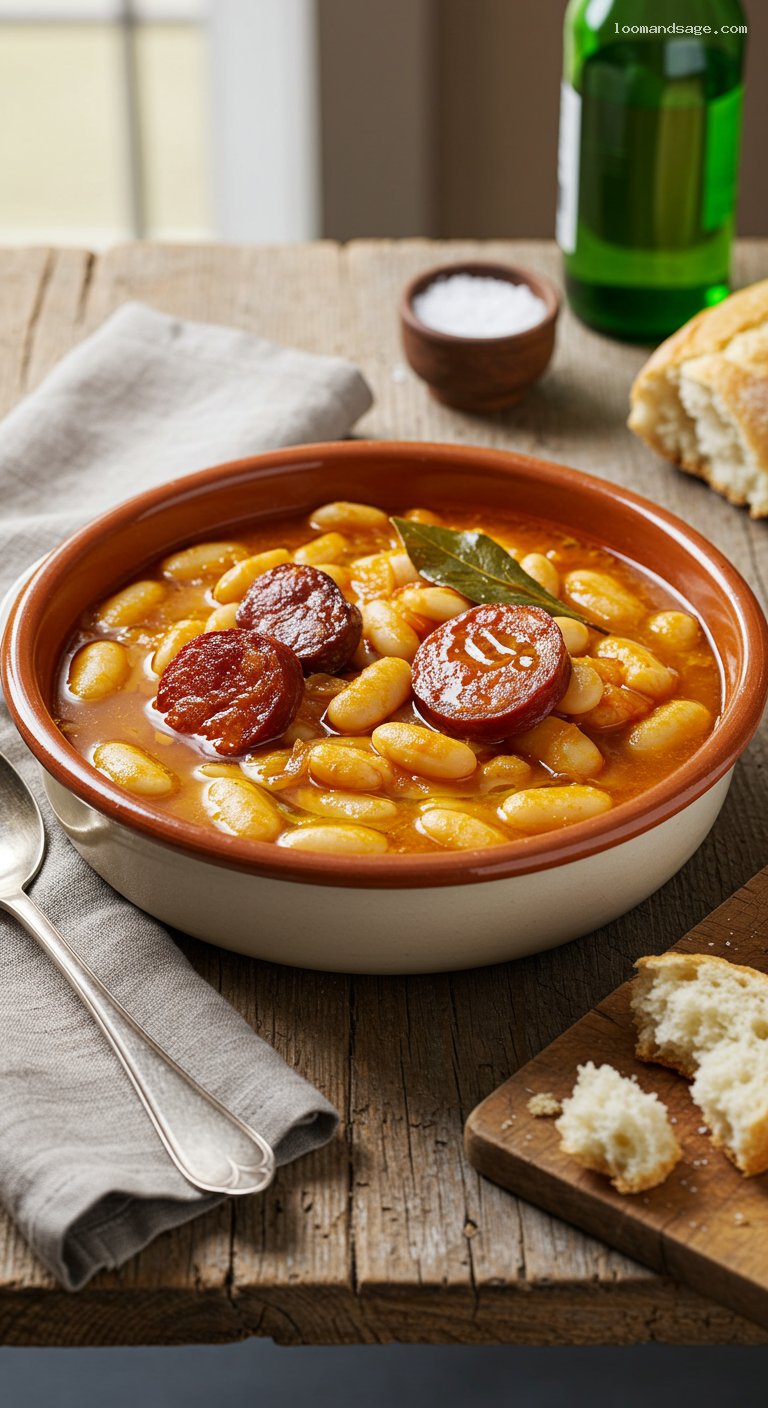Quick Recipe Version (TL;DR)
Quick Ingredients
- 1 lb (450 g) dried fabes (Asturian white beans) or large white beans
- 2 tbsp kosher salt for soaking, plus 1–1 1/2 tsp to finish
- 2 Asturian chorizo sausages (about 8 oz/225 g total)
- 2 Asturian morcilla sausages (about 8 oz/225 g total)
- 6 oz (170 g) pancetta slab or salted pork belly
- 1 small onion (peeled, left whole)
- 3 garlic cloves (peeled, lightly crushed)
- 1 bay leaf
- 1 tsp sweet smoked paprika (pimentón dulce) + 1/4 tsp hot paprika (optional)
- Pinch saffron threads (about 20 threads), bloomed in 2 tbsp hot water
- 2 tbsp extra-virgin olive oil
- 6 cups (1.4 L) cold water, plus more as needed
- Crusty bread, to serve
Do This
- 1. Pick over and rinse beans; soak 8–12 hours in 2 qt (2 L) water + 2 tbsp kosher salt. Drain and rinse.
- 2. Pierce chorizo and morcilla; cut pancetta into large chunks. Bloom saffron in 2 tbsp hot water.
- 3. In a wide heavy pot, add beans, meats, onion, garlic, bay, paprika, olive oil, and 6 cups cold water.
- 4. Bring slowly to a gentle simmer. Skim foam; add saffron infusion. Keep at a bare simmer (about 185°F/85°C).
- 5. During first 45 minutes, “asustar” the beans 2–3 times by adding 1/4 cup cold water if simmer gets lively; swirl the pot, do not stir.
- 6. Continue to simmer 1–1 1/2 hours until beans are tender and broth is creamy; top up with hot water as needed.
- 7. Remove onion and bay. Slice meats; return to pot. Season with 1–1 1/2 tsp salt. Rest 15 minutes and serve with crusty bread.
Why You’ll Love This Recipe
- Authentic Asturian comfort food with classic compango: chorizo, morcilla, and pancetta.
- Silky, saffron-scented broth and buttery beans that stay intact and tender.
- Foolproof low-and-slow method with the traditional “asustar” technique to protect the beans.
- Even better the next day, perfect for make-ahead entertaining with crusty bread.
Grocery List
- Produce: 1 small onion, 3 garlic cloves, 1 bay leaf, parsley (optional garnish)
- Dairy: None
- Pantry: Dried fabes or large white beans, saffron threads, sweet smoked paprika, hot paprika (optional), kosher salt, extra-virgin olive oil, crusty bread; Asturian chorizo, Asturian morcilla, pancetta slab (or salted pork belly)
Full Ingredients
Beans
- 1 lb (450 g) dried fabes (Asturian large white beans) or large white beans (e.g., alubia blanca, large lima, or cannellini)
- 2 qt (2 L) cold water + 2 tbsp kosher salt for soaking
- 6 cups (1.4 L) cold water for cooking, plus more as needed
Compango (Meats)
- 2 Asturian chorizo sausages (about 8 oz/225 g total), left whole and lightly pierced
- 2 Asturian morcilla sausages (about 8 oz/225 g total), left whole and lightly pierced
- 6 oz (170 g) pancetta slab or salted pork belly, cut into 2–3 large chunks
- Optional: 1 small cured ham bone or serrano ham rind
Aromatics & Seasoning
- 1 small onion, peeled and left whole (or halved)
- 3 garlic cloves, peeled and lightly crushed
- 1 bay leaf
- 1 tsp sweet smoked paprika (pimentón dulce)
- Optional: 1/4 tsp hot smoked paprika (pimentón picante)
- Pinch saffron threads (about 1/2 tsp loosely packed or 20 threads), bloomed in 2 tbsp hot water
- 2 tbsp extra-virgin olive oil
- Kosher salt to finish: start with 1 to 1 1/2 tsp, then adjust to taste
To Serve
- Crusty country bread, warmed
- Optional: chopped parsley and a drizzle of olive oil

Step-by-Step Instructions
Step 1: Sort and soak the beans
Pick over beans to remove any debris, then rinse well. In a large bowl, dissolve 2 tbsp kosher salt in 2 qt (2 L) cold water. Add beans and soak 8–12 hours at room temperature. Drain and rinse. Brining helps skins stay intact and centers turn creamy. If you forgot to soak, quick-soak by boiling beans for 2 minutes, covering, and resting 1 hour; drain and proceed (beans may split more).
Step 2: Prep the compango and aromatics
Lightly pierce the chorizo and morcilla a few times so they release flavor without bursting. Cut pancetta into 2–3 large chunks. Peel the onion (leave whole or halve it) and lightly crush the garlic cloves. Bloom the saffron in 2 tbsp hot water and set aside.
Step 3: Load the pot and bring to a gentle simmer
In a wide, heavy 5–6 quart pot or Dutch oven, combine soaked beans, chorizo, morcilla, pancetta, onion, garlic, bay leaf, sweet paprika, optional hot paprika, and olive oil. Add 6 cups (1.4 L) cold water to cover the beans by about 1 inch. Set over medium-low heat and bring slowly to a bare simmer, 20–30 minutes. Avoid rapid boiling, which toughens skins and clouds the broth.
Step 4: Skim, add saffron, and keep it gentle
As the pot reaches a simmer, skim off any foam. Stir in the saffron and its soaking liquid. Adjust heat to maintain a very gentle simmer at about 180–190°F (82–88°C) if you have a thermometer—just a few lazy bubbles. Do not stir with a spoon; instead, gently swirl the pot occasionally to prevent sticking and keep beans intact.
Step 5: Use the asustar technique and cook until creamy
During the first 45 minutes, “asustar” the beans 2–3 times: if the simmer becomes lively, splash in 1/4 cup cold water to calm it. Continue to cook, uncovered or partially covered, until the beans are tender and the broth turns creamy and lightly thickened, 1 hour 45 minutes to 2 hours 15 minutes total. Keep beans just submerged—add hot water in small amounts as needed.
Step 6: Slice meats, season, and finish
Lift out the chorizo, morcilla, and pancetta to a board. Remove the onion and bay leaf (discard). Slice the sausages into thick rounds and cut pancetta into bite-size pieces; return them to the pot. Season with 1 to 1 1/2 tsp kosher salt, then simmer 10 minutes more to meld flavors. If the broth seems thin, mash 1/2 cup beans and stir back in, or simmer gently uncovered for 5–10 minutes.
Step 7: Rest and serve
Take the pot off heat and let it rest 15–20 minutes—the broth will thicken and flavors deepen. Ladle into warm deep bowls, making sure each serving gets a mix of beans and meats. Drizzle with a little olive oil, garnish with parsley if you like, and serve with plenty of crusty bread.
Pro Tips
- Use true Asturian fabes if you can; their thin skins and buttery texture are ideal. Large lima or alubia blanca are good substitutes.
- Keep the simmer gentle and avoid vigorous stirring to prevent split skins. Swirl the pot instead.
- Salt late. Even with a brine soak, final salting near the end keeps beans tender and the broth properly seasoned.
- Leave the sausages whole during cooking; slice near the end so they flavor the broth without drying out.
- Rest the stew before serving—this short pause transforms the broth from good to luxurious.
Variations
- Oven method: After step 3, cover and bake at 300°F (150°C) for 2–2 1/2 hours until tender, checking water level once or twice.
- Pressure cooker: Combine ingredients as in step 3, lock lid, cook at high pressure for 30 minutes, then natural release 20 minutes. Finish with slicing meats and salting as directed.
- No morcilla available: Replace with additional chorizo and a small smoked ham hock, or use Spanish black pudding if you can find it.
Storage & Make-Ahead
Fabada improves overnight. Cool completely, then refrigerate up to 4 days or freeze up to 3 months. Reheat gently over low heat until steaming, adding a splash of water as needed. For the best texture, store sausages whole and slice when reheating. Leftovers thicken; loosen with hot water or stock.
Nutrition (per serving)
Approximate values: 690 calories; 37 g protein; 48 g carbohydrates; 43 g fat; 7 g fiber; 1500 mg sodium. Values will vary based on exact sausages and pancetta used.


